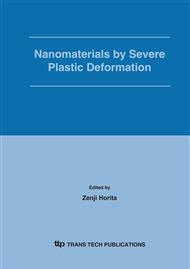p.681
p.687
p.693
p.699
p.705
p.711
p.717
p.721
p.727
Microstructural Change of Beta Type Titanium Alloy by Intense Plastic Deformation
Abstract:
Usual static recrystallization treatment and a method to provide intense plastic deformation, ARB namely Accumulative Roll-Bonding, have been applied to two beta type titanium alloys, i.e. Ti-29Nb-13Ta-4.6Zr and Ti-15V-3Cr-3Sn-3Al. Microstructural change as well as work-hardening behavior was examined as a function of plastic strain. Both the work-hardening rate and the hardness at the initial as-hot-rolled state were smaller in the Ti-Nb-Ta-Zr alloy than in the Ti-V-Cr-Sn-Al alloy. Recrystallized grains of 14μm in size were obtained by the usual static recrystallization treatment, which was significantly smaller than that of the starting as-hot-rolled plate of 38μm. No significant change other than flattening and elongating of the original grains was found in the optical microscopic scale. It was revealed, however, from a TEM observation combined with selected area diffraction technique that geometric dynamic recrystallization occurred in the Ti-Nb-Ta-Zr alloy deformed at room temperature by a true strain of 5, resulting in an ultra-fine-grained microstructure where the grain size was roughly estimated to be about 100nm.
Info:
Periodical:
Pages:
705-710
Citation:
Online since:
January 2006
Price:
Сopyright:
© 2006 Trans Tech Publications Ltd. All Rights Reserved
Share:
Citation:


